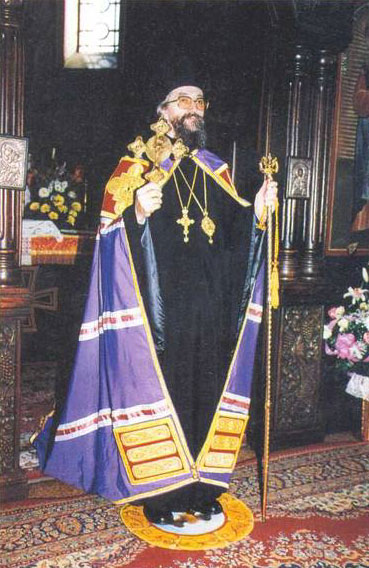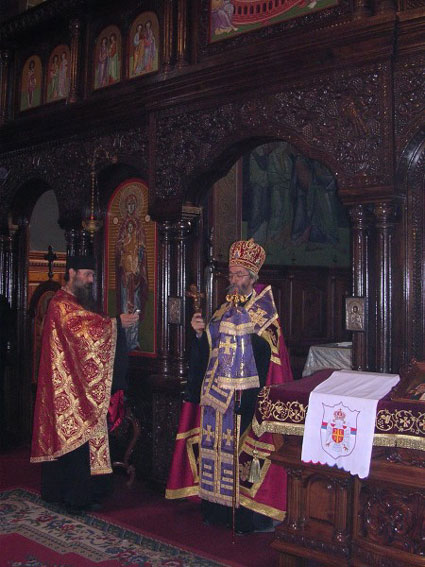|
![]() |
BISHOP OF BANJA LUKA EPHRAIM NEW CHAIRMAN OF
JASENOVAC COMMITTEE
Holy Assembly of Bishops of the Serbian Orthodox Church on its session on November 2 2005 decided to accept request of His Grace (former) Bishop of Zahumlje and Herzegovina Atanasije (Jevtić) and relieve him of his post as chairman of Jasenovac Committee, due to the condition of his health. At the same time, Holy Assembly of Bishops also accepted a proposal of Bishop Atanasije and asked His Grace Bishop of Banja Luka Jefrem (Serbian pronunciation of Ephraim) to accept the duty of the chairman of the Committee.
Bishop of Banja Luka Jefrem (Milutinović) was born on April 15 1944 in the village of Busnovi near city of Prijedor, today in Republic of Srpska, Bosnia and Herzegovina. Elementary and high school he finished in his native village and in nearby town of Sanski Most. He became a monk in the Monastery of Liplje on July 9 1967. Bishop Jefrem finished studies at the Theological Seminary in the Monastery of Krka in Dalmatia in 1971 and at the Theological Academy in Moscow in 1975. He was ordained as hierodeacon by Bishop of Banja Luka Andrej on January 14 1968 and as hieromonk on Pentecost, July 14 1970, both in the Cathedral Church of the Holy Trinity in Banja Luka.
Bishop Jefrem graduated on the Academy in Moscow with work The Teaching of Saint Basil the Great on Monasticism and earned title “Candidate of Theology”. Holy Synod of the Serbian Church appointed him same year as teacher at the “The Holy Three Hierarchs” Theological Seminary at Krka Monastery. In the course of time, Bishop Jefrem resumed duty of Seminary’s main tutor as well. Hieromonk Jefrem was elected for Vicarius Bishop of Moravice on June 1 1978 and ordained on September 17 same year. For Bishop of Banja Luka he was elected in May 1980 and on June 1 his enthronement took place.
Although communists still ruled, the situation in the war-thorn diocese was improving and political changes and opening in the eighties were used for recovery of the Church. Sadly, this recovering was followed by well-known tragic events: common state was destroyed and civil war ignited; all that affected heavily the Serbian Orthodox Church and Serbian people. Nevertheless, at the same time but on the alternate track spiritual renaissance of the people continued and the Church reestablished its natural role in people’s life, showing its ancient and eternal vitality.
It can be said that his utmost efforts and energies during his twenty-five years bishoprics Bishop Jefrem invested in rebuilding and recovery of diocese destroyed in World War Two. The plan of Ustaše was to establish Banja Luka as the capital of their Independent State of Croatia. Therefore, the ultimate goal of Pavelić was to purge mostly Serbian, Orthodox and rebellious Bosnian Krajina from its inhabitants this way or another; Germans themselves were devoted to destroy the hotspot of uprising as well. Consequences for the Church were catastrophic.
The killing and burial field of concentration camp Jasenovac - Donja Gradina - is on the territory of the Diocese of Banja Luka, same as the number of other killing fields, “The Brains Cemetery” around Saint Mark’s church in Draksenić and village of Drakulić being most famous and most terrible examples. The substance of Serbian victims of Jasenovac came from this diocese, especially after German and Croatian offensive in summer 1942 when about 60,000 people was exiled from the area and sent to concentration and death camps all over Croatia.
Among the first victims of Ustaše terror was Bishop of Banja Luka Platon (Jovanović), who refused Ustaše order to leave his diocese; he was tortured and subsequently murdered on May 5 1941. The Holy Assembly of Bishops accepted proposal of Bishop Jefrem and Bishop Platon was canonized; his healing relics are in the church of the Holy Trinity. The old cathedral church of Christ the Savior was initially destroyed by Ustaše in 1941 and its remnants were removed and scattered by communists in 1945; in this moment church is almost completely rebuilt and the first liturgy was served last September.
Thus, those two, the Cathedral Church and Holy Bishop Platon together with Jasenovac and Donja Gradina, became symbols of New Martyrdom not only of the Diocese of Banja Luka, but also of the whole Serbian Orthodox Church. But in the same time, they became symbols of its resurrection.
| |
 |
| |
 |
|